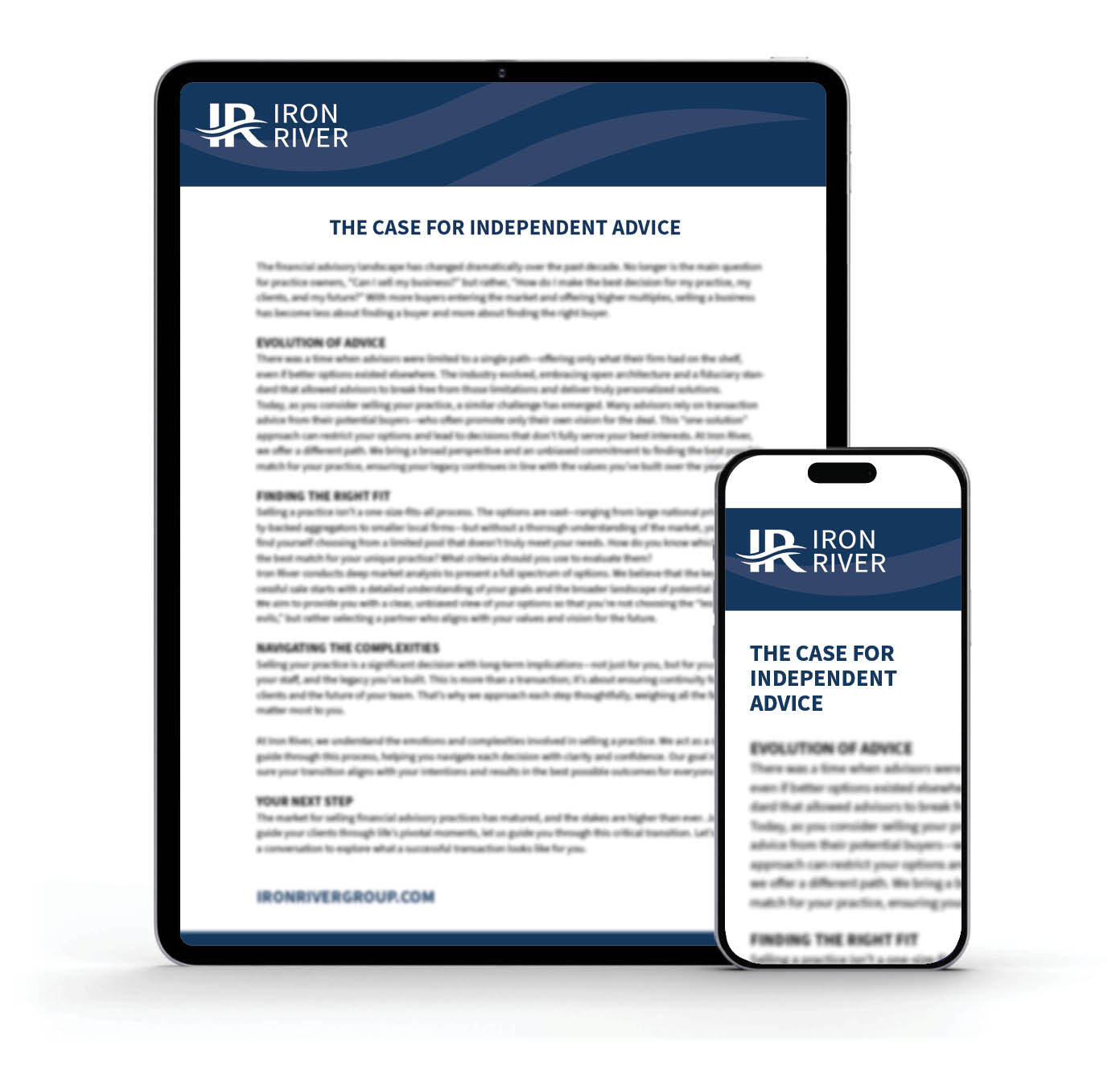Three Pillars of M&A
Ownership can shift, teams can grow, and systems can evolve, but for clients, one expectation remains constant, their relationship must feel the same or better. A transition should never create uncertainty about the plan, the people, or the process they rely on.
Clients don’t think in terms of deal structures or valuations. They think about who answers their calls, who understands their goals, and whether their financial plan is still on track. When those things remain consistent or improve, trust is strengthened. When they don’t, value erodes fast. A firm’s goodwill, retention rate, and brand reputation all hinge on how clients experience the change.
The best transactions are invisible at first. Clients sense continuity in communication, responsiveness, and service quality. Their reports look familiar. Their meetings stay on schedule. They see the same advisor sitting across the table, still focused on their goals. Over time, they begin to experience the benefits of the merger: new planning capabilities, improved technology, deeper investment research, and a stronger support team. When this happens, the deal becomes more than a transaction, it becomes an enhancement to the client’s financial life.
A client-first transition starts long before closing. It begins with thoughtful preparation, clear communication, and aligned intent between buyer and seller. The most successful firms prioritize messaging that is proactive and empathetic. Clients should understand the “why” before they ever wonder “what this means for me.” Advisors who communicate early and clearly protect confidence through transparency. That reassurance is what keeps relationships intact when ownership changes hands.
When designed well, the transaction itself becomes a client benefit. They gain access to broader resources and a deeper bench of professionals. They may see better reporting, lower custodial costs, or expanded service offerings such as tax, estate, or insurance integration. These improvements build loyalty, because clients recognize that their firm has evolved for their benefit, not at their expense.
And behind every successful client transition is a team that makes it possible. Employees are the ones who maintain the consistency clients feel, the ones who carry culture, deliver service, and uphold promises during periods of change. The next pillar focuses on those individuals, and how the people inside the firm determine whether clients continue to feel that same sense of trust, stability, and care long after the deal is done.
They are the face, the voice, and the culture of the firm. When employees feel valued and supported, clients feel it too. A firm can have the strongest deal structure and the best integration plan on paper, but without engaged employees, even the best designed transaction will fall short.
There is a common misconception in M&A that a buyer’s goal is to overhaul the existing team. In reality the opposite is true. Buyers place a premium on firms where the team is intact, engaged, and prepared to carry the business forward. The strongest acquirers understand that client relationships, culture, and continuity live within the people, not the balance sheet. A buyer may enhance the team with additional resources, but the goal is supplementation, not replacement. What is valuable is not just the revenue of the firm, but the people who protect it, grow it, and deliver on the client experience every day.
That reality is felt most directly by employees. They experience the merger up close. They absorb uncertainty about change, workflow, and reporting structures long before it reaches clients. How leadership communicates through that uncertainty determines whether they feel empowered or anxious. When a team feels informed and trusted, they move confidently through the transition and project that same confidence to clients. When they feel left out or uncertain, it erodes trust at every level.
Retention is both a cultural and strategic goal. Key employees carry relationships, institutional knowledge, and operational stability. They are often the difference between a smooth transition and a fractured one. The best acquirers and sellers prioritize retention early, aligning incentives and growth opportunities well before closing. That alignment signals to employees that the new chapter is one of continuity and opportunity, not disruption.
Integration is more than merging systems or combining office spaces. It is about preserving the elements of culture that make people proud to show up every day. Firms that approach integration as a two-way process, learning from both sides, build stronger and more unified teams. Empathy and inclusion at this stage turn uncertainty into engagement, transforming what could feel like a takeover into a shared vision.
Employees define how clients experience a firm’s brand, and they sustain that experience through every season of change. Their attitude, communication, and consistency determine whether clients continue to feel cared for and understood.
With clients protected and employees positioned for continuity and growth, the final pillar comes into view. A transition must create meaningful benefit for the shareholders, but it cannot do so at the expense of the client experience or the stability of the team. The firms that achieve the best outcomes are the ones that structure deals where shareholder value is created because clients and employees are supported, not in spite of them. That is where the next chapter begins.
They make the decision to sell, recapitalize, or merge, setting the trajectory for the firm’s future. Their motivations vary, whether succession, growth, or liquidity; but the best outcomes occur when their goals align with the needs of both clients and employees.
Every deal begins with a question of value, yet value is more than a number: price matters and so does fit. Lean too far toward price; cultural alignment and retention suffer. Lean too far toward fit; owners may leave enterprise value on the table. The most effective transactions find balance, recognizing that valuation, structure, and incentives are tools that shape long term outcomes.
How a transaction is structured often has as much impact as the headline number. Earn outs, equity rollovers, retention pools, and performance-based triggers determine whether owners remain engaged and whether employees stay motivated. Both of these factors determine whether clients experience continuity. Compensation drives behavior, and this stage presents a rare opportunity to design a model where everyone benefits. In M&A, structure can be customized to reflect priorities, not just the buyer’s initial template.
Negotiation reveals more than financial expectations. It reveals what matters most. A deal focused only on immediate payout may overlook levers that drive long term enterprise value. A structure that favors alignment but neglects economics may feel principled, but it leaves money on the table during a once-a-lifetime transaction. Successful owners understand that value is created in how economics, culture, and incentives are balanced to sustain momentum long after closing.
Preparation and clarity are central to owner success. When owners communicate purpose and structure clearly, they give employees and clients confidence that the transition is intentional. That clarity maintains trust and keeps momentum through the more complex phases of a deal.
Owners set the tone for how a firm evolves after closing. Their mindset determines whether integration feels like an ending or the beginning of a stronger chapter. By balancing price with fit, economics with culture, and liquidity with alignment, owners create an environment where all three pillars support each other. That alignment is what defines lasting M&A success.
This is only the beginning. The real outcome of a transaction is not determined in a conference room. It is revealed slowly, in how clients respond, in how employees show up, and in how owners feel about the future they set in motion.
That is why alignment becomes the true measure of M&A success. A transaction only holds its value when all three pillars move forward together. Clients remain loyal when their experience stays consistent and their trust feels justified. Employees stay engaged when they see opportunity, clarity, and respect for their role in what comes next. Owners realize both liquidity and legacy when the firm continues to grow with strength, not hesitation.
Each pillar reinforces the others. Clients stay because the team that serves them stays. The team stays because the structure, incentives, and message from ownership signal continuity and shared benefit. Owners find fulfillment in the outcome because what they built does not end at closing. It evolves, with momentum, into its next chapter.
A deal can be priced well and still fall short if alignment is missing. Conversely, when alignment is present, a transaction becomes more than a liquidity event. It becomes a moment of acceleration. Clients feel supported. Employees feel valued. Owners feel confident that both value and legacy have been honored.
Alignment does not happen by chance. It is designed into the process. It is reflected in communication, structure, and decision making. It is the difference between a transaction that simply transfers equity and one that strengthens the enterprise for years to come.
If a transition is in your future, now is the moment to shape alignment, not react to it. The firms that win are not the ones that rush to market. They are the ones that prepare with clarity, structure, and intention. That preparation is not theoretical work. It is practical. It is strategic. And it is exactly where Iron River goes to work.

Tyson Pettitt
Founder
Tyson founded Iron River to guide wealth management firms through M&A transactions. His experience in both operating and transacting wealth management practices positions him to understand your goals and drive successful outcomes. Focused on strategy, fit, and long-term growth, each transaction is hand-crafted to drive expansion, while preserving the values that define your firm. A Vermont native, Tyson now resides in St. Petersburg, Florida with his golden retriever, Tenney. A former collegiate rower, he stays active skiing, golfing, or in the gym.
White Paper: The Case for Independent Advice
Ready to sell your advisory practice but unsure how to find the right buyer? Download our white paper to explore how thoughtful guidance and a broad market perspective can help you secure the best fit for your future, clients, and legacy.

Get Started
Partner with Iron River to simplify your M&A process and achieve your goals with a personalized approach that preserves your firm’s legacy.
